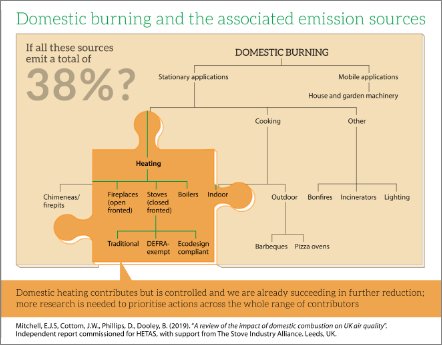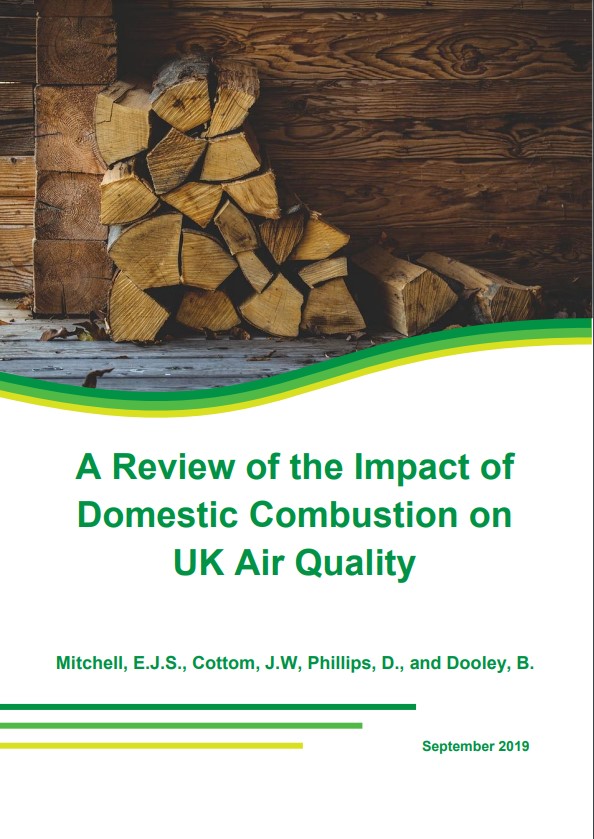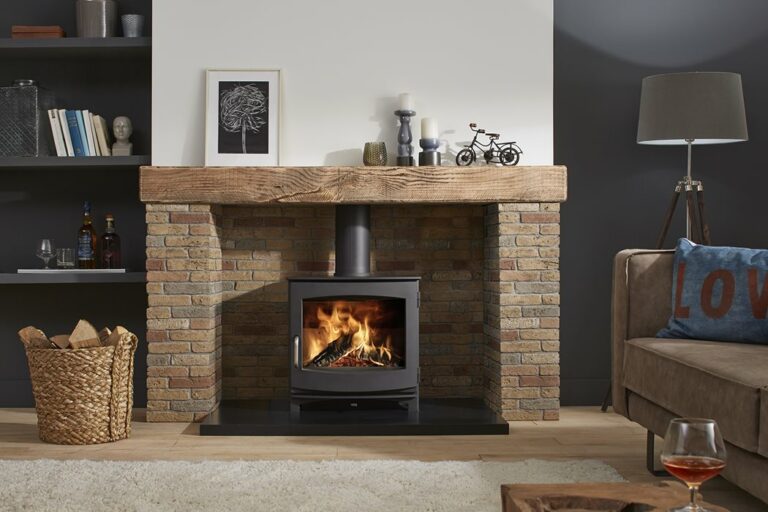
Lockdown leads to fall in air pollution
Air pollution has fallen in many areas across the UK as lockdown measures take effect. This trend mirrors the reductions seen across Europe and China. So what impact is the impact of domestic burning on air quality?
Data collected by the National Centre for Atmospheric Science (NCAS) shows marked reductions in nitrogen dioxide (NO2) and in particulate matter (PM2.5). The data focused on ten UK cities, displayed in the following order: Birmingham, Belfast, Bristol, Cardiff, Glasgow, Leeds, London, Manchester, Newcastle, York.
The data comes from background air monitoring stations in cities, sited away from main roads. Locations were chosen as they are close to where people live.
At a more local level, we have seen recent increases in PM2.5 emissions during the lockdown period, areas such as Bromley. It is understood increased levels are thought to have been purely driven by bonfires, additional pollution coming into the south-east corner of the country from across the channel – combined with pollutants not being dispersed in the calm, still air – contributed to the jumps. The review commissioned by HETAS called for regulation to the most polluting sources, such as bonfires which remain largely unregulated.the Clean Air Plan for Wales is looking to address this issue. Read our summary on the current situation with UK air quality policies here (link needed).
The impact of domestic combustion

Towards the end of 2019 a review of the impact of domestic combustion on the UK was published. The work was commissioned by HETAS. The review is an extensive and important piece of work for our industry, especially given the current focus on air quality. We would advise all of our registrants to take some time to read through the review, which is available on the HETAS website.
The research and report was co-authored by Edward J.S. Mitchell PhD, Joshua Cottom PhD, Douglas Phillips PhD and Ben Dooley PhD and has been subsequently peer reviewed by Professor Alan Williams CBE, FREng University of Leeds and Professor Jenny Jones FRSC, MEI University of Leeds.

The aim of the report was to give a high-level critical review of the contribution of domestic burning to UK air pollution with the intention to better understand the uncertainties of current estimates, especially in relation to domestic combustion. To do this the research team used existing literature and methodologies in relation to ambient air source apportionment methods, primary and secondary emissions, activity data, PM emission contribution estimates, associated emission factors, and the potential influence of other known emission sources.
Evidence presented in the review indicates that the 38% contribution shown in the UK 2019 Clean Air Strategy, described as arising from domestic burning, has large uncertainties in many of the underlying methods and data. The cumulative effect of these uncertainties means that the 38% value is highly likely to be inaccurate and the review called for more reliable methods and further analysis.
Key review areas
The extensive review covered several key areas:
- source apportionment methods
- analysis of the PM measuring techniques
- a review of a wide range of global domestic burning contribution studies
- analysis of primary and secondary emissions accounting methods
- analysis of the impacts of particle toxicology
- emissions inventories for domestic burning
- investigates alternate sources of biomass burning and their scale to better understand how they may contribute to overall PM emissions
The investigation in each of these areas highlights uncertainties present in the 38% value reported to be attirbuted to domestic combustion.
Source Apportionment
Section 2 of the review looked in depth at source apportionment methods and came to a number of important conclusions. There are two common apportionment methods for domestic burning, aethalometers and levoglucosan; however, these cannot distinguish definitively between different biomass burning sources. The majority of aethalometers used for quantitative monitoring within the UK carry high levels of uncertainty due to large amounts of variation within the instruments default values. Although there are improved versions of aethalometers which are much less prone to interference, these have not widely been applied in the UK. Additionally, levoglucosan, which is produced by the pyrolysis of cellulose, is often used as a marker for wood-burning stove use. However, as cellulose is found in all types of biomass, this should actually be considered a marker for biomass burning in general, with the specific source not easily identifiable. Other potential sources of biomass burning include wildfires, prescribed burning, bonfires and barbecues to name a few. Data is presented that suggests these alternate sources are common in the UK and can lead to substantial PM emissions, and therefore should be considered alongside solid-fuel stoves in top-down source apportionment studies.
For bottom-up source apportionment methods, data on the estimated use (activity data) is combined with emission factors to determine the total emissions over a period of time. Within the UK, the National Atmospheric Emission Inventory (NAEI) is the body responsible for this. They estimated wood burning increased from 1.8m tonnes in 2005 to 4.8m tonnes in 2017, based on data derived from the Government’s Domestic Wood Use Survey. Applying seasonal regression, this estimate equates to 16.7 kg of wood burned per household per day during the peak heating months. This calculated wood consumption appears to be considerably out of proportion, greatly exceeding that from other countries, and when compared to other more recent industry surveys in the UK, it equates to more than double their reported value. If the recent lower estimate is applied, the total contribution of stoves to PM drops to 9.6% for PM10 and 14.9% for PM2.5.
With the current headlines, source apportionment is an important issue here. The work in section two of the review poses some interesting points.
The two most common source apportionment methods for domestic burning are aethalometers and levoglucosan, but these cannot distinguish exclusively between different biomass burning sources.
Most aethalometers used in the UK network of 14 monitoring sites are two wavelength instruments. By measuring the difference in the ratio of light absorption at the lower wavelength and the higher wavelength, high black carbon emission sources (e.g. diesel vehicles) can be separated from high brown carbon emission sources (e.g. biomass burning). Using a two-wavelength aethalometer for quantitative source apportionment of domestic burning carries a high level of uncertainty because there is considerable variation in the default values of Ångström exponent used by the instrument. It is recommended that a seven wavelength version of the instrument be used in combination with another source apportionment technique which is less prone to interference.
Levoglucosan is often used as a marker for domestic wood burning, but it is produced by the pyrolysis of cellulose and therefore is a marker for biomass burning in general which can include wildfires, prescribed burning, agricultural burning, barbecues, bonfires, cigarette smoke and some cooking. The amount of PM attributable to wood/biomass burning is calculated by multiplying the concentration of levoglucosan by a fixed ratio of 10.7. This is derived from a 2008 study where the ratio of levoglucosan to PM was measured in the emissions from a now 25 year old Austrian tiled stove, which may not be representative of modern UK appliances. Since levoglucosan emission factors may vary by a factor of 5 or more depending on fuel type and appliance type, the applicability of the 10.7 factor may be called into question for UK specific circumstances. We recommend that this factor be determined from a typical UK stove and fuel combination for future use.
Most pollution sources, including domestic burning, emit both primary PM (that directly emitted from the stove) and precursors of secondary PM (additional particles formed by reactions in the atmosphere). Within primary PM, there can be reductions in emissions of 88.6% for an advanced stove/boiler relative to an open fireplace. There is also a reduction in the amount of organic material in the PM and hence a reduction in toxicity. Toxicity can be reduced by 3 times for an advanced stove compared to a traditional stove or open fire. • Formation of secondary PM can significantly increase the mass of PM emitted by a stove. This is a result of precursor gases (e.g. VOCs and NOX) reacting in the atmosphere and forming additional particles. Evidence is presented that secondary organic aerosol formation is highest from the start-up phase and can be reduced to near zero during stable combustion in an efficient modern appliance.
Emissions Inventories
In Section 2 of the review, the team looked at emissions inventories for domestic burning, more specifically the information provided by the National Atmospheric Emissions Inventory (NAEI). Much of the data provided in relation to domestic combustion is derived from the Government’s Domestic Wood Use Survey.
The survey found that domestic wood fuel use had been previously underestimated by a factor of three and therefore the estimations of activity data and emissions increased significantly in subsequent versions of the NAEI. The accuracy of this survey has been called into question by some, with the argument being made that the amount of wood consumed in the domestic sector is now overestimated in the NAEI. If the activity estimates in the NAEI were found to be overestimated, the total emissions and relative contribution of domestic burning are likely to also be overestimated.
In 2019, the SIA published the results of an industry-led survey into the habits of wood fuel users in the UK (SIA, 2019). The results of the survey suggest that domestic wood consumption may have been overestimated in the BEIS survey by as much as a factor of 2.4. This is likely to have a significant effect on total emissions in the NAEI and on the relatively source contributions.
The review also notes that there are a number of regulatory emissions limits which apply to domestic burning appliances, including the Clean Air Act, the Renewable Heat Incentive, technologyand nominal power-based British standards, and most recently the European Ecodesign Directive.
In summarising the emissions inventories the review came to the following conclusions.
Within the National Atmospheric Emissions Inventory (NAEI), domestic burning is dominated by natural gas, heating oil and wood fuels. The amount of wood burned is said to have increased from 1.8 million tonnes in 2005 to 4.8 million tonnes in 2017. This number is derived from the Government’s Domestic Wood Use Survey which found that previous figures for the amount of wood consumed was underestimated by a factor of three based on a sample of 1,206 wood fuel users. Applying a seasonal regression analysis to this data would mean that 1.06 million tonnes of wood is burned in the peak heating months, equating to 16.7 kg per household per day. This is significantly higher than use in other countries.
Data from HMRC shows that 93 thousand tonnes of wood fuel were imported and 73 thousand tonnes were exported in 2018 though this does not include UK-grown and used wood. Data from an industry survey of 10,620 wood fuel users revealed that wood fuel is used for heating for 4.7 months of the year, with an estimated total of 1.87 million tonnes of wood burned per year. This is up to a factor of 2.4 (61%) lower than NAEI estimates.
When it came to emissions contributions, according to the NAEI, total PM10 emissions from domestic burning were 45.1 kilotonnes in 2017, of which 43.6 kilotonnes were from solid fuels and 38.8 kilotonnes were from wood burning. NAEI data shows that domestic wood burning contributed to 23.1% of national PM10 emissions and 35.8% of national PM2.5 emissions in 2017 but given the reduction in activity data above this is expected to reduce to 9.6% of PM10 and 14.9% of PM2.5 respectively.
Emissions factors of PM2.5, NOx and CO for domestic wood burning in the NAEI are 443 g/GJ, 63 g/GJ and 2,856 g/GJ respectively. This PM2.5 emissions factor is 3 times higher than the limit under the Ecodesign regulations. Replacing open fires and older stoves could therefore have a significant impact. Evidence is presented from the literature demonstrating that appliances can and do meet the emissions limits for Ecodesign and therefore it is possible that emissions factors are overestimated in the NAEI. Further evidence is required for the appropriate average emissions factors to be used in the NAEI which represents the current mix of appliance types and ages
UK obligations and the wider picture
Section 4 looks at the bigger picture, including Europe and our obligations to reduce air pollution. The UK and EU member states are required to reduce emissions of SO2, NOx, NH3, NMVOC and PM2.5 by 2020 and 2030 under the Gothenburg Protocol and the NEC Directive. Major efforts are required for all member states in order to meet the more stringent 2030 targets (Reductions of 33% for SO2, 36% in PM2.5 and 40% in NOx compared to 2017 emissions). Current forecasts suggest for the UK, projections based on current measures indicate that compliance will not be attained for all pollutants. However, as outlined in section 3 of the review revisions to UK domestic burning activity data in line with the industry survey could mean that the UK is more likely to meet its PM2.5 reduction targets under the revised Gothenburg Protocol and the NEC Directive. Additionally, achieving WHO Guideline is likely to be challenging, requiring emissions reductions across multiple sectors including domestic burning. However, given the uncertainties in activity data and in source apportionment, it is likely that the contribution of domestic stoves and fireplaces to PM2.5 concentrations is lower than current estimates.
Other solid fuel combustion sources
Section 5 of the review addressed these alternate PM sources and their scale to better understand how they may contribute to overall emissions and how their levels of uncertainty can conflict in the source apportionment of domestic burning sources.
Whilst wood burning stoves must meet Building Regulations, Smoke Control Area limits and Ecodesign limits from 2022 many domestic burning forms are largely unregulated. Areas that the review looked at included domestic barbeques, commercial cooking, open burning of waste/bonfires and non-domestic emission sources such as wildfires, prescribed burning and agricultural burning.
Barbeques can have significant emissions of PM and are an increasingly popular method to cook food with 9.5 million units imported since 2015, and a rise in charcoal imports totalling around 86,000 tonnes per year in 2018. Commercial cooking may be an important source of PM emissions, with woodfired pizza ovens alone consuming around 7 kg/hr of wood.
Bonfire night is known to cause peaks in PM emissions capable of exceeding WHO 24h exposure limits. The NAEI states that in 2017, 1.4 kt of PM10 and 1.2 kt of PM2.5 derived from bonfire night.
Conclusions from the review
The review recommends thorough, evidence-based analysis be given to the methods, assumptions and limitations behind the calculation of the domestic burning contribution to the UK’s emissions.
Key recommendations from the review and areas of future work are as follows:
- Appliances & Monitoring
• Improved Monitoring Equipment; support the extensive uptake and utilisation of more accurate measurement techniques, including 7 (seven) wavelength aethalometers, chemical mass balance and positive matrix factorisation. Additionally, it is important that the fixed ratio methods for attributing levoglucosan concentrations are further investigated to ensure their validity when applied within the UK.
• Review Existing Inventory Datasets; it is vital that the existing activity data and emissions factors used are revised to properly represent the emissions associated with domestic burning.
• Stove and Open Fire Upgrades; replacing older, less efficient stoves and open fires with new models – that meet Ecodesign regulation – is a simple and effective method for reducing the current PM emissions associated with domestic burning.
- Policy & Research Support
• Research Support into Other Emission Sources; the correct implementation of air quality policy decisions first requires the robust quantification of all significant sources of pollutants. It is vital that research is conducted into the use of other sources such as barbecues, fire pits, commercial cooking, wildfires and open burning.
• Domestic Burning Emissions Expert Panel; establish a cross-sector expert panel, helping to bring industry, academia and policymakers together, facilitating greater collaboration within the area of domestic burning.
• Increased Funding Sources; improve the availability of funding for local authorities to properly investigate and monitor their local air quality conditions, cooperating with researchers and industrial partners to ensure that the correct actions are initiated. This should also extend to engagement activities within their local communities.
- Public Perception
• Knowledge Generation; the public are currently largely uninformed on the impact of domestic burning. Ensuring that accurate evidence-based information is disseminated and made openly available to the public should take precedence.
• Outreach Programmes; effectively promote the ‘best practices’ for stove use and other domestic burning appliances. This should include correct methods for stove use and advice on wood fuel quality.
- Take strategic & targeted action to reduce domestic burning emissions
• Apply regulation to the most polluting sources; appliances used for outdoor heating and cooking such as barbecues, chimeneas, pizza ovens, firepits and garden incinerators pose a health hazard if they continue to be unregulated. They are also an extremely inefficient use of fuel in comparison to modern Ecodesign-ready stoves and boilers.
• Support replacement of open fires and traditional stoves; target the 27.4% of appliances which are open fires or stoves older than 10 years.
• Support consumers to choose the lowest emission appliances; consumers currently have no incentive to purchase an appliance that exceeds Ecodesign limits. Providing some incentive will promote competition and the greater uptake of automatic pellet stoves and topof-the-range wood stoves.
• Encourage users to burn only high quality renewable fuel; 52% of users burn wood only, transitioning the remaining users away from coal to smokeless fuels will improve air quality, and towards wood and biomass will reduce greenhouse gas emissions.
- Consider the role of domestic biomass burning in climate and air quality targets
• If heat pumps are widely prioritised for domestic heating, particularly in off-gas grid properties, there may be a need for low-cost supplementary heating during the winter months. Modern high efficiency low-emission biomass stoves have the potential to supply this supplementary heat demand either as a separate appliance or a hybrid heating system.
• 2030 emissions reductions obligations under the NEC Directive and revised Gothenburg Protocol are unlikely to be met without targeted action in the domestic burning sector. The same is true of achieving WHO guideline PM2.5 concentrations.
Our industry has taken a number of measures in recent years and is committed to improving air quality. HETAS continues to work with government, it’s devolved authorities and at a local level on all domestic combustion issues.
Further Information
The full 125 page report can be downloaded via the HETAS Technical Hub (password required). We advise our registrants to take some time to understand the key points raised in the reivew.
Search here for Ecodesign Compliant stoves and boilers.
Find out more about the Woodsure Ready to Burn scheme.
Information published by the National Centre for Atmospheric Science can be viewed here.
Keep up to date with latest developments on air quality and policies at www.hetas.co.uk and our monthly newsletters.



